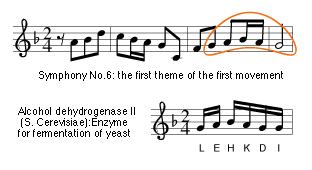At the beginning of the 90s', Pasco, a trade name of a big company for production and sales of bread, has been producing "musical bread" on order. The "Pastoral Symphony" of Beethoven was diffused during fermentation of dough for 72 hours, which is far more time than normal. Obtained bread has been said to be delicious, full of mildness, aroma and tastiness. However, the bread was expensive for daily purchase because of much time and labor required for the production. Therefore, the bread seems to have been used for a gift, for example: bread made under music might have given a favorable impression and could have become a topic of conversation. However, why the "Pastoral Symphony" is effective for making bread? It is Dr. Sternheimer who has explained such interesting and mysterious effects from the view point of "protein music". To make bread, we must prepare flour, water, yeast, and so on. Whether baked bread becomes tasty or not depends mainly on the activity of yeast during the fermentation, provided that the same food stuffs are used. Therefore, by promoting the activity of enzyme called alcohol dehydrogenase (ADH), which is contained in bread yeast and plays an important role in fermentation, during the fermentation of dough with the use of music, one can obtain tasty bread. Used melody is, of course, that obtained by decoding the amino acid sequence of ADH. A blind test was planned for comparing the taste between the "musical bread" and normal bread without music. About 30 people contributed to the test. The result was just as expected: the musical bread was by far preferred.
However, so far as bread production is concerned, there is a remarkable difference between the melody of ADH and the "Pastoral Symphony". Efficiency for making the bread is completely different: the melody of ADH was diffused for an hour and a half, which is the normal fermentation time, but about fifty times more effective than the 72 hours of the "Pastoral Symphony". Such difference arises from the fact that the whole melody of ADH is effective, while only small portions are in the "Pastoral Symphony". If non-specific music is used, such as other common classical pieces, more than one month will be required before obtaining some positive effects. The degree of effectiveness can be obtained by calculating the quantity of information contained in each melody. If protein music comes to be used in the near future for food production including a fermentation or brewing step, we may be able to obtain, without considerable additional labor, delicious bread, good beer, wine and sake, and miso paste and soy sauce with high quality. We are looking forward to enjoying the pleasure of table surrounded by such foods. |
 Back to the "Pastoral Symphony", a melody fragment for activating
ADH is contained in the theme of the first movement of the symphony, as
can be seen on the score below. This is just the reason why tasty bread
can be made with the "Pastoral Symphony".
Back to the "Pastoral Symphony", a melody fragment for activating
ADH is contained in the theme of the first movement of the symphony, as
can be seen on the score below. This is just the reason why tasty bread
can be made with the "Pastoral Symphony".